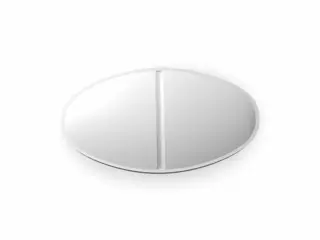Buy Theophylline Online in Ireland
| Package | Dosage | Price | Price per Dose | |
|---|---|---|---|---|
| Dosage: 400mg | ||||
| 360 pill | 400mg | €302.71 | €0.84 | |
| 180 pill | 400mg | €164.36 | €0.91 | |
| 120 pill | 400mg | €120.60 | €1.01 | |
| 90 pill | 400mg | €100.50 | €1.11 | |
| 60 pill | 400mg | €75.67 | €1.27 | |
| 30 pill | 400mg | €46.11 | €1.55 | |

Theophylline Description
Introduction to Theophylline
Theophylline is a medication commonly used to manage respiratory conditions, particularly asthma and chronic obstructive pulmonary disease (COPD). It belongs to the class of drugs known as methylxanthines, which have bronchodilator properties. By relaxing the muscles around the airways, Theophylline helps to improve airflow, making breathing easier for individuals suffering from airway constriction.
How Theophylline Works
The medication exerts its effect by inhibiting phosphodiesterase enzymes, which results in increased levels of cyclic AMP within the smooth muscle cells of the respiratory tract. This biochemical change causes relaxation of bronchial muscles and reduces airway inflammation. Additionally, Theophylline has some anti-inflammatory effects, which can contribute to symptom relief. It is often used as a preventative treatment rather than for immediate relief during a sudden asthma attack.
Proper Usage and Dosing
The dosage of Theophylline varies depending on age, medical condition, and response to the medication. Typically, it is administered orally, either as a tablet or liquid form. Due to its narrow therapeutic window, it is crucial for patients to follow their healthcare provider’s instructions carefully. Regular blood tests are usually recommended to monitor the drug’s levels and avoid toxicity. Patients should not adjust their dose without medical advice and should inform their doctor about any other medications they are taking to prevent adverse interactions.
Possible Benefits of Theophylline
Many patients find Theophylline effective in controlling chronic respiratory symptoms. It can reduce the frequency and severity of asthma attacks and improve lung function over time. Some may experience fewer side effects compared to other bronchodilators, especially in long-term management. For individuals who do not respond well to inhaled medications, Theophylline may serve as an alternative or adjunct therapy.
Common Side Effects and Risks
Like all medications, Theophylline can cause side effects. Mild symptoms include nausea, vomiting, headaches, and gastrointestinal discomfort. More serious adverse effects may include rapid heart rate, irregular heartbeat, insomnia, or tremors. Because of its narrow therapeutic index, overdose is particularly dangerous and can lead to severe symptoms such as seizures or cardiac arrhythmias. Patients should be vigilant and seek medical attention if they experience any unusual or severe side effects.
Precautions and Interactions
Patients with pre-existing conditions like heart disease, liver or kidney impairment should inform their healthcare provider before starting Theophylline. Certain medications, including antibiotics, anticonvulsants, and other bronchodilators, can interact with Theophylline, affecting its efficacy or increasing the risk of adverse effects. Lifestyle factors such as smoking can also influence the drug’s metabolism, requiring dose adjustments. Regular medical supervision ensures safe and effective use of the medication.
Conclusion
Theophylline remains a valuable option in the management of chronic respiratory diseases. Its ability to improve airway airflow and reduce symptoms makes it an important tool for many patients. However, careful monitoring and adherence to medical guidance are vital due to potential side effects and interactions. When used properly, Theophylline can significantly enhance quality of life for those with bronchial conditions.
See Also


